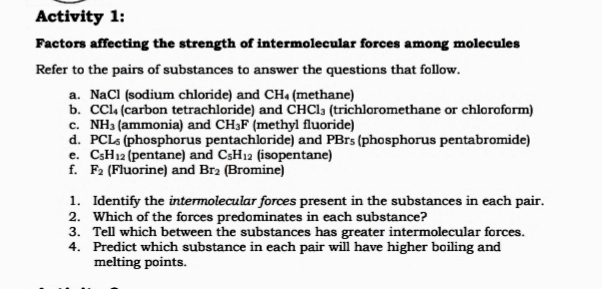d. PCLs (phosphorus pentachloride) and PBrs (phosphorus pentabromide) e. CSH2 (pentane) and CSH12 (isopentane) f. Fa (Fluorine) and Bra (Bromine) 1. Identify the intermolecular forces present in the substances in each pair. 2. Which of the forces predominates in each substance? 3. Tell which between the substances has greater intermolecular forces. 4. Predict which substance in each pair will have higher boiling and melting points.
d. PCLs (phosphorus pentachloride) and PBrs (phosphorus pentabromide) e. CSH2 (pentane) and CSH12 (isopentane) f. Fa (Fluorine) and Bra (Bromine) 1. Identify the intermolecular forces present in the substances in each pair. 2. Which of the forces predominates in each substance? 3. Tell which between the substances has greater intermolecular forces. 4. Predict which substance in each pair will have higher boiling and melting points.
Chemistry for Engineering Students
4th Edition
ISBN:9781337398909
Author:Lawrence S. Brown, Tom Holme
Publisher:Lawrence S. Brown, Tom Holme
Chapter8: Molecules And Materials
Section: Chapter Questions
Problem 8.92PAE
Related questions
Question
Answer number 4,letter d,e and f subparts

Transcribed Image Text:Activity 1:
Factors affecting the strength of intermolecular forces among molecules
Refer to the pairs of substances to answer the questions that follow.
a. NaCl (sodium chloride) and CHa (methane)
b. CCL4 (carbon tetrachloride) and CHC1, (trichloromethane or chloroform)
c. NH3 (ammonia) and CH3F (methyl fluoride)
d. PCLS (phosphorus pentachloride) and PBrs (phosphorus pentabromide)
e. CSH12 (pentane) and CSH12 (isopentane)
f. F2 (Fluorine) and Br2 (Bromine)
1. Identify the intermolecular forces present in the substances in each pair.
2. Which of the forces predominates in each substance?
3. Tell which between the substances has greater intermolecular forces.
4. Predict which substance in each pair will have higher boiling and
melting points.
Expert Solution
This question has been solved!
Explore an expertly crafted, step-by-step solution for a thorough understanding of key concepts.
Step by step
Solved in 2 steps with 2 images

Knowledge Booster
Learn more about
Need a deep-dive on the concept behind this application? Look no further. Learn more about this topic, chemistry and related others by exploring similar questions and additional content below.Recommended textbooks for you

Chemistry for Engineering Students
Chemistry
ISBN:
9781337398909
Author:
Lawrence S. Brown, Tom Holme
Publisher:
Cengage Learning

Introductory Chemistry: An Active Learning Approa…
Chemistry
ISBN:
9781305079250
Author:
Mark S. Cracolice, Ed Peters
Publisher:
Cengage Learning

Chemistry: An Atoms First Approach
Chemistry
ISBN:
9781305079243
Author:
Steven S. Zumdahl, Susan A. Zumdahl
Publisher:
Cengage Learning

Chemistry for Engineering Students
Chemistry
ISBN:
9781337398909
Author:
Lawrence S. Brown, Tom Holme
Publisher:
Cengage Learning

Introductory Chemistry: An Active Learning Approa…
Chemistry
ISBN:
9781305079250
Author:
Mark S. Cracolice, Ed Peters
Publisher:
Cengage Learning

Chemistry: An Atoms First Approach
Chemistry
ISBN:
9781305079243
Author:
Steven S. Zumdahl, Susan A. Zumdahl
Publisher:
Cengage Learning


Chemistry
Chemistry
ISBN:
9781305957404
Author:
Steven S. Zumdahl, Susan A. Zumdahl, Donald J. DeCoste
Publisher:
Cengage Learning

General Chemistry - Standalone book (MindTap Cour…
Chemistry
ISBN:
9781305580343
Author:
Steven D. Gammon, Ebbing, Darrell Ebbing, Steven D., Darrell; Gammon, Darrell Ebbing; Steven D. Gammon, Darrell D.; Gammon, Ebbing; Steven D. Gammon; Darrell
Publisher:
Cengage Learning